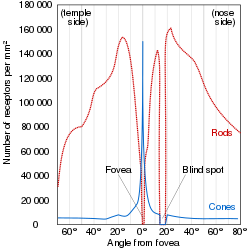
Back نقطة عمياء (رؤية) Arabic Сляпо петно Bulgarian অন্ধবিন্দু Bengali/Bangla Slijepa mrlja BS Punt cec Catalan Slepá skvrna Czech Blinder Fleck (Auge) German Τυφλό σημείο (όραση) Greek Blinda makulo (biologio) Esperanto Punto ciego Spanish
This article needs additional citations for verification. (November 2011) |

A blind spot, scotoma, is an obscuration of the visual field. A particular blind spot known as the physiological blind spot, "blind point", or punctum caecum in medical literature, is the place in the visual field that corresponds to the lack of light-detecting photoreceptor cells on the optic disc of the retina where the optic nerve passes through the optic disc.[2] Because there are no cells to detect light on the optic disc, the corresponding part of the field of vision is invisible. Via processes in the brain, the blind spot is interpolated based on surrounding detail and information from the other eye, so it is not normally perceived.
Although all vertebrates have this blind spot, cephalopod eyes, which are only superficially similar because they evolved independently, do not. In them, the optic nerve approaches the receptors from behind, so it does not create a break in the retina.
The first documented observation of the phenomenon was in the 1660s by Edme Mariotte in France. At the time it was generally thought that the point at which the optic nerve entered the eye should actually be the most sensitive portion of the retina; however, Mariotte's discovery disproved this theory.
The blind spot in humans is located about 12–15° temporally and 1.5° below the horizontal and is roughly 7.5° high and 5.5° wide.[3]
- ^ Brian A. Wandell (1 January 1995). Foundations of Vision. Sinauer Associates. ISBN 978-0-87893-853-7.
- ^ Gregory, R., & Cavanagh, P. (2011). "The Blind Spot". Scholarpedia. Retrieved on 2011-05-21.
- ^ MIL-STD-1472F, Military Standard, Human Engineering, Design Criteria For Military Systems, Equipment, And Facilities (23 Aug 1999) PDF
© MMXXIII Rich X Search. We shall prevail. All rights reserved. Rich X Search
